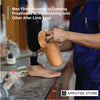3D Printing Is Critical to This Cycling Pro’s Success
Fitting a leg for an adaptive athlete is a delicate process. A lot of things must be considered, such as comfort, fit, and leg power. For Paralympic champion Denise Schindler, a lot of things need to work together, but crucial to her success is having the best leg, which can only be designed with the help of 3D scanning and printing.

Schindler is a pro adaptive cyclist. She has bagged several Paralympic metals and won the World Championship three times. The latter alone would qualify her as the top female adaptive cyclist in the world. Schindler is a below-the-knee amputee, and she wears a prosthesis on her right leg.
Schindler discovered biking when she found herself in a gym class with stationary bikes. She realized that, compared to running, she could bike with her prosthetic without pain. She took her newfound love for the sport on the road by riding through the Bavarian Alps. After that, Schindler entered pro adaptive cycling, and the rest, as they say, is history.
Biking with a prosthesis
Biking with a prosthetic leg is an entirely different experience compared to biking with a biological limb. It requires more energy and power from the user. In a previous interview with Engineering.com, Schindler noted that although cycling is not as strenuous as adaptive running, her leg power is noticeably diminished when pedaling. She knows this because her bike is equipped with a dual power meter—one for each of her legs—to monitor the difference.
While an adaptive cyclist can only do so much to compensate for the power loss, many take comfort in the fact that prosthetic legs can be changed, and that prosthetic technology is evolving.
One of Schindler's favorite cycling legs is made of carbon fiber and doesn't include a foot. Instead of a prosthetic foot, Schindler attaches her leg directly to the pedal, giving the prosthetic an appearance of a thin shin bone. This prosthetic design gives her the aerodynamic advantage that she needs.
Fitting for a cycling leg
When fitting everyday prosthetics, most prosthetists might go for an exact fit, depending on the prosthetic user's lifestyle. However, unlike everyday prosthetics, performance prosthetics don't need to fit precisely to the residual limb. One way to ensure that adaptive athletes get the fit required of their sport is through 3D scanning and a software called Autodesk.
In Schindler's case, the Autodesk team tasked with creating her biking prosthetic began the development process with a 3D scan of her residual limb. The 3D scan was used to create a leg model that only made contact with the skin on the sides of her residual limb, not the ultra-sensitive bottom.
A 3D-printed version of her prosthetic leg is then created based on the scan. For Schindler, the team ensured that the prosthetic socket didn't include any material that would touch the bottom of her residual limb, thus providing a comfortable ride.
The next step in the process included multiple fittings. In Schindler's case, her prosthetic fittings involved as many as 22 people, and one prosthetic socket may need to go through as many as four fittings.
Schindler's cycling prosthesis is estimated to be about €8,000 to €12,000 ($9,453 to $14,218). The cost of 3D printing is $350—a small part of the total price, but it makes a huge difference.
Furthermore, 3D scanning and printing allowed her finished prosthetic cycling leg to be completed after 48 hours—a significant time reduction from the standard six weeks of production time.
Schindler's success as an adaptive athlete is, of course, not entirely dependent on her performance prosthetic leg, but it plays an important part. Just as any athlete, Schindler works hard to strengthen her legs and depends on her team to create the optimal leg using 3D printing technology.









































































